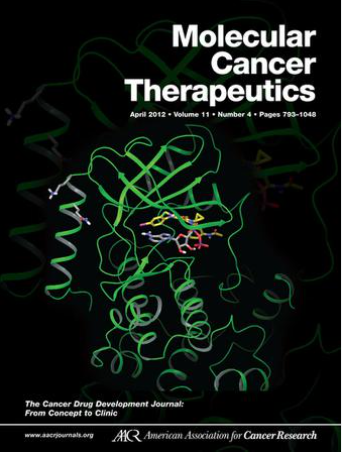摘要 B027:推断儿科癌症合成致死关系的路径信息框架
IF 5.3
2区 医学
Q1 ONCOLOGY
引用次数: 0
摘要
合成致死性是指两个突变基因的结合导致细胞死亡,由于其在癌症中的治疗潜力,合成致死性已被广泛研究。尽管实验检测合成致死率是常见的做法,但在这里,我们扩展了一个计算框架,利用基因突变的共生来推断合成致死率,并将路径纳入其中。通路将突变基因聚合成一个功能单元,能够揭示包含低突变频率基因(如儿科癌症中的基因)的关系,否则就无法通过检测单个基因对观察到这种关系。我们提出的框架是利用突变数据和通路知识进行更有针对性的合成致死性搜索的另一种途径。我们根据突变基因的共现推断潜在的合成致死关系。共同出现的频率低于预期,即所谓的互斥性(ME),表示潜在的合成致死关系,而出现频率高于预期(CO)则表示潜在的有利关系。在这一框架中,我们从 Reactome 中选择了一组生物通路,在两个公开的儿科癌症数据集 TARGET 和 DKFZ 中汇总了每个肿瘤的每个通路的基因突变(具有高/中度影响的 SNV 和嵌合体)。这样就得到了每个肿瘤的突变通路图谱,并使用 rediscover 对其共存性进行测试。测试会输出重要的共现和互斥通路,我们从中提取出潜在的突变基因对。然后,对共存和互斥基因对在 BioGRID 和 SynLethDB 中的通路外显性、蛋白质复合物及其存在进行注释。最后,在文献中检验了所提出的基因对的有效性。该测试在 TARGET 中检测到 439 个(ME:369,CO:70)重要的通路对,在 DKFZ 中检测到 49 个(ME:31,CO:18)重要的通路对,涉及多种癌症类型。其中,在 TARGET 中提取了 3185 个基因对(ME:2671,CO:514),在 DKFZ 中提取了 331 个基因对(ME:16,CO:315)。这些关系明显多于仅检测基因对时发现的关系。通路有助于部分减少亚型或通路表观性导致的结果。例如,基因检测在 TARGET-B-ALL 中发现的 FLT3-KRAS,在通路检测中却检测不到。该检验还能在较小的数据集中发现互斥(ME)基因对。在 TARGET 基因测试中最初发现的 Wilms 肿瘤中的 ME 基因 TP53-DROSHA 和 AML 肿瘤中的 KIT-NRAS 在相应癌症类型的 DKFZ 数据集中也被检测到。除TP53-DROSHA外,在DKFZ的Wilms肿瘤中还发现了TP53-DGCR8 ME,表明微处理器复合体突变ME与TP53突变有关。总之,我们提出了一个以通路为基础的儿科癌症合成致死推断框架,通过利用已有的数据和数据库信息,探索突变基因之间的合成致死关系和其他复杂的功能关系,作为后续实验的另一种途径。引用格式:Anastasia Spinou, Richard Gremmen, Puck Veen, Jarno Drost, Patrick Kemmeren.推断小儿癌症合成致死关系的路径信息框架[摘要]。In:AACR 癌症研究特别会议论文集:扩展和转化癌症合成脆弱性;2024 年 6 月 10-13 日;加拿大魁北克省蒙特利尔。费城(宾夕法尼亚州):AACR; Mol Cancer Ther 2024;23(6 Suppl):Abstract nr B027.本文章由计算机程序翻译,如有差异,请以英文原文为准。
Abstract B027: A pathway-informed framework to infer synthetic lethal relationships in pediatric cancer
Synthetic lethality, the combination of two mutated genes which results in cell death, has been greatly investigated due to its therapeutic potential in cancer. Despite the common practice of experimentally detecting synthetic lethality, here we extend a computational framework that employs co-occurrence of gene mutations to infer synthetic lethality by incorporating pathways. Pathways aggregate the mutated genes into a functional unit and give power to uncover relationships containing genes of low mutation frequency e.g. in pediatric cancer, which otherwise would not be observed by testing individual gene pairs. Our proposed framework is an alternative avenue to a more focused synthetic lethality search by exploiting mutation data & pathway knowledge. We infer potentially synthetic lethal relationships based on mutated gene co-occurrence. A less often than expected co-occurrence, or so-called mutual exclusivity (ME), indicates a potentially synthetic lethal relationship whereas one that occurs more often than expected (CO) indicates a potentially advantageous relationship. In this framework we use a selected set of biological pathways from Reactome to aggregate gene mutations per pathway for each individual tumor (SNVs and indels with high/moderate impact) within two public pediatric cancer datasets, TARGET and DKFZ. This results in mutated-pathway profiles per tumor which are tested for co-occurrence using rediscover. The test outputs significant co-occurring and mutually exclusive pathways from which we extract the underlying mutated gene pairs. The co-occurring and mutually exclusive gene pairs are then annotated for pathway epistasis, protein complexes and their presence in BioGRID and SynLethDB. Finally, the validity of the proposed gene pairs is examined in literature. The test detected 439 (ME: 369, CO:70) significant pathway pairs in TARGET and 49 (ME: 31, CO:18) in DKFZ across several cancer types. Out of these, 3185 gene pairs were extracted in TARGET (ME: 2671, CO: 514) and 331 (ME: 16, CO: 315) in DKFZ. These relationships are significantly more than the ones found when testing solely for gene pairs. Pathways aid in partially decreasing findings due to subtype or pathway epistasis. For example, FLT3-KRAS found in TARGET-B-ALL by the gene test is not detected by the pathway test. The test was, also, able to uncover mutually exclusive (ME) gene pairs in smaller datasets. The initially found ME genes TP53-DROSHA in Wilms tumors and KIT-NRAS in AML tumors in TARGET by the gene test, were detected in the corresponding cancer types’ DKFZ datasets. In addition to TP53-DROSHA, TP53-DGCR8 were found ME in Wilms tumors of DKFZ, indicating the microprocessor complex mutations ME to TP53 mutations. To sum up, we present a pathway-informed synthetic lethality inference framework for pediatric cancer to explore synthetic lethal relationships and other complex functional relationships between mutated genes by exploiting already existing data and database information as an alternative avenue for follow-up experimentation.
Citation Format: Anastasia Spinou, Richard Gremmen, Puck Veen, Jarno Drost, Patrick Kemmeren. A pathway-informed framework to infer synthetic lethal relationships in pediatric cancer [abstract]. In: Proceedings of the AACR Special Conference in Cancer Research: Expanding and Translating Cancer Synthetic Vulnerabilities; 2024 Jun 10-13; Montreal, Quebec, Canada. Philadelphia (PA): AACR; Mol Cancer Ther 2024;23(6 Suppl):Abstract nr B027.
求助全文
通过发布文献求助,成功后即可免费获取论文全文。
去求助
来源期刊
CiteScore
11.20
自引率
1.80%
发文量
331
审稿时长
3 months
期刊介绍:
Molecular Cancer Therapeutics will focus on basic research that has implications for cancer therapeutics in the following areas: Experimental Cancer Therapeutics, Identification of Molecular Targets, Targets for Chemoprevention, New Models, Cancer Chemistry and Drug Discovery, Molecular and Cellular Pharmacology, Molecular Classification of Tumors, and Bioinformatics and Computational Molecular Biology. The journal provides a publication forum for these emerging disciplines that is focused specifically on cancer research. Papers are stringently reviewed and only those that report results of novel, timely, and significant research and meet high standards of scientific merit will be accepted for publication.

 求助内容:
求助内容: 应助结果提醒方式:
应助结果提醒方式:


